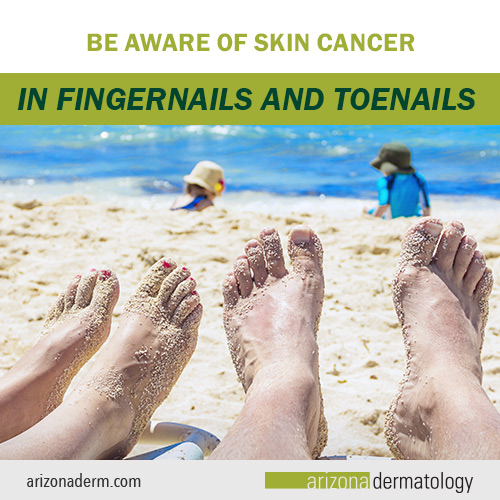 When we think of skin cancer, the first image that comes to mind is often a suspicious mole on the skin’s surface. However, skin cancer can manifest in unexpected places, including the nails.
When we think of skin cancer, the first image that comes to mind is often a suspicious mole on the skin’s surface. However, skin cancer can manifest in unexpected places, including the nails.
Skin cancer in the nails, known as subungual melanoma, is a rare but serious form of cancer that arises in the pigment-producing cells (melanocytes) beneath the nails. This condition is more prevalent in the nails of the fingers than in the toes. Recognizing the signs and symptoms is crucial for early detection and successful treatment.
Signs and Symptoms:
- Discoloration: One of the earliest signs of subungual melanoma is a dark streak or band appearing on the nail. The color may vary from brown to black, and it might extend from the nail bed to the tip.
- Changes in Nail Shape: The affected nail may undergo changes in shape, such as thickening, distortion, or an irregular border. You might be tempted to overlook these changes, attributing them to trauma or fungal infections, but they should be thoroughly examined.
- Bleeding and Ulceration: As the cancer progresses, bleeding or ulceration under the nail may occur, accompanied by pain or tenderness. This is a more advanced stage of the cancer.
Risk Factors
Several factors may increase the risk of developing subungual melanoma:
- Age: Being over the age of 50 increases your risk.
- Sun Exposure: Prolonged exposure to UV radiation, either from natural sunlight or artificial sources like tanning beds, can contribute to the development of skin cancer, including subungual melanoma.
- Skin Type: Individuals with fair skin, light eyes, or numerous moles are at a higher risk.
- Personal or Family History: A personal or family history of skin cancer increases the likelihood of developing subungual melanoma.
- Immunodeficiency: Having a condition that weakens the immune system, such as HIV, can increase your risk.
Prevention and Early Detection:
- Sun Protection: Protecting your hands and feet from excessive sun exposure is crucial. Use sunscreen with a high SPF and wear protective clothing, such as gloves, when outdoors for extended periods.
- Regular Self-Examinations: Conduct regular self-examinations of your nails, checking for any unusual changes in color, shape, or texture. If you notice anything suspicious, seek prompt medical attention.
- Skin Cancer Screenings: During an annual skin cancer screening, your dermatologist will do a full-body examination to look for any signs of skin cancer.
While skin cancer in the nails is relatively rare, its consequences can be severe if left untreated. Being aware of the signs and risk factors, along with practicing sun protection and regular self-examinations, is vital for early detection and successful management. If you notice any concerning changes in your nails, consult an Arizona Dermatology dermatologist promptly.


